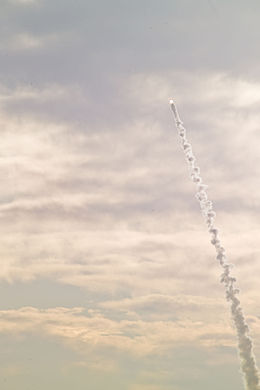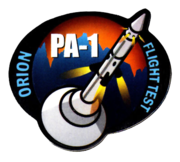Pad Abort-1
 Launch of the Pad Abort 1 test | |
| Mission type | Abort test |
|---|---|
| Operator | NASA |
| Mission duration | 95 seconds |
| Distance travelled | 2.1 kilometers (6,900 ft) |
| Apogee | 1.8 kilometers (6,000 ft) |
| Spacecraft properties | |
| Spacecraft type | Orion boilerplate |
| Start of mission | |
| Launch date | May 6, 2010, 13:03:00 UTC |
| Rocket | Orion Launch Abort System |
| Launch site | White Sands [1] |
| End of mission | |
| Landing date | May 6, 2010, 13:04:35 UTC |

Orion program | |
Pad Abort 1 (PA-1) was a flight test of the Orion Launch Abort System (LAS). Orion was a component of Constellation,[dubious ] a human spaceflight project within NASA, the space agency of the United States. PA-1 was the first test in a sequence of atmospheric flight tests known as Orion Abort Flight Test (AFT).
PA-1 tested the basic functionality of the launch abort concept from the pad in its preliminary Orion design configuration. It used the former conformal shape of the LAS adapter. The Flight Test Article (FTA) vehicle will differ from production Orion vehicles in a number of ways. For example, the FTA will not have a crew on board, and the avionics will be a prototype of what is planned for production Orions.[2]
The PA-1 Test took place at the U.S. Army's White Sands Missile Range in New Mexico.
Spacecraft location[]
The Orion capsule used in the test is on display at the Virginia Air and Space Center in Hampton, Virginia.[3]
Gallery[]

Pad Abort-1 (PA-1) stack at White Sands Missile Range, N.M.

Pad Abort 1 (PA-1) launched May 6, 2010 at White Sands

Parachute descending

PA-1 Crew Module post landing

PA-1 on display at the Virginia Air and Space Center
References[]
![]() This article incorporates public domain material from websites or documents of the National Aeronautics and Space Administration.
This article incorporates public domain material from websites or documents of the National Aeronautics and Space Administration.
- ^ "NASA Building Test Pad at White Sands for New Spacecraft". redOrbit. February 3, 2008. Retrieved September 12, 2008.
- ^ Idicula; et al. "A Flight Dynamics Perspective of the Orion Pad Abort One Flight Test" (PDF). AIAA.
- ^ "The Virginia Air and Space Center to Begin Construction on New Gallery, IMAX Theater". Virginia Air and Space Center. Retrieved September 24, 2020.
External links[]
| Wikimedia Commons has media related to Pad Abort-1 (Orion). |
- Orion Pad Abort 1 Video Highlights at Vimeo – http://vimeo.com/11631855
- Orion (spacecraft)
- Constellation program missions
- Test spaceflights
- 2010 in spaceflight
- 2010 in New Mexico






